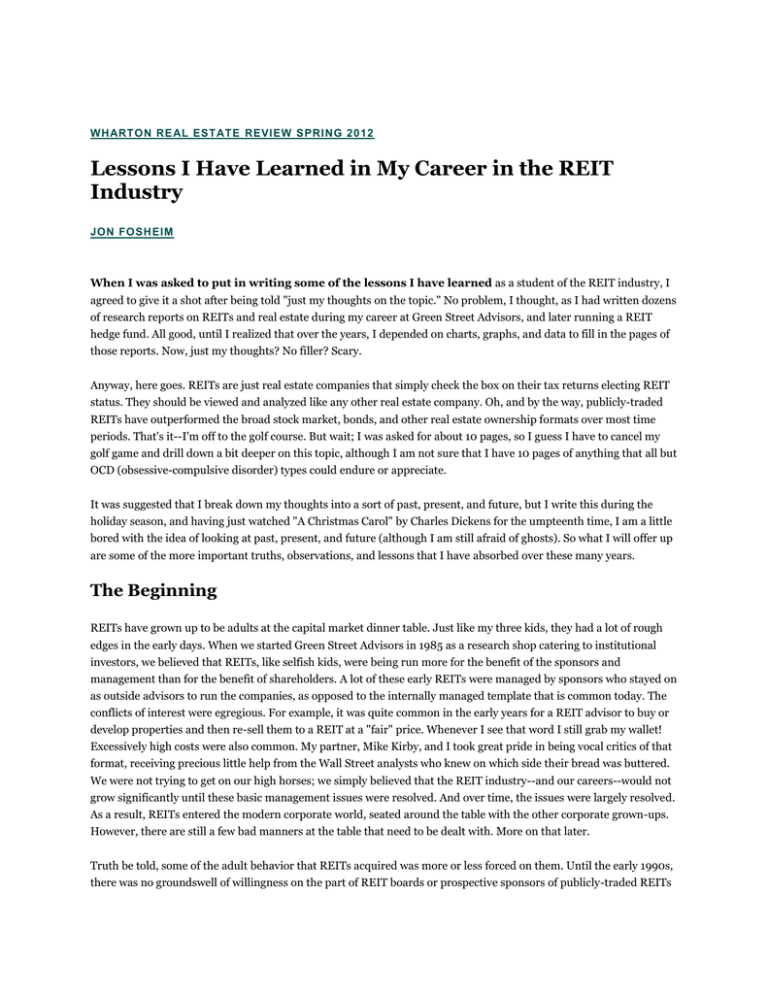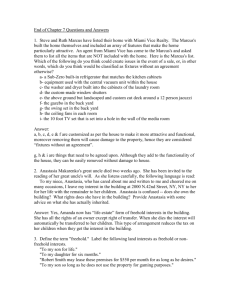Lessons I Have Learned in My Career in the REIT Industry
advertisement

SPRING 2012 WHARTON RE AL EST ATE REVI EW SPRI NG 2012 Lessons I Have Learned in My Career in the REIT Industry JON FOSHEIM When I was asked to put in writing some of the lessons I have learned as a student of the REIT industry, I agreed to give it a shot after being told "just my thoughts on the topic." No problem, I thought, as I had written dozens of research reports on REITs and real estate during my career at Green Street Advisors, and later running a REIT hedge fund. All good, until I realized that over the years, I depended on charts, graphs, and data to fill in the pages of those reports. Now, just my thoughts? No filler? Scary. Anyway, here goes. REITs are just real estate companies that simply check the box on their tax returns electing REIT status. They should be viewed and analyzed like any other real estate company. Oh, and by the way, publicly-traded REITs have outperformed the broad stock market, bonds, and other real estate ownership formats over most time periods. That's it--I'm off to the golf course. But wait; I was asked for about 10 pages, so I guess I have to cancel my golf game and drill down a bit deeper on this topic, although I am not sure that I have 10 pages of anything that all but OCD (obsessive-compulsive disorder) types could endure or appreciate. It was suggested that I break down my thoughts into a sort of past, present, and future, but I write this during the holiday season, and having just watched "A Christmas Carol" by Charles Dickens for the umpteenth time, I am a little bored with the idea of looking at past, present, and future (although I am still afraid of ghosts). So what I will offer up are some of the more important truths, observations, and lessons that I have absorbed over these many years. The Beginning REITs have grown up to be adults at the capital market dinner table. Just like my three kids, they had a lot of rough edges in the early days. When we started Green Street Advisors in 1985 as a research shop catering to institutional investors, we believed that REITs, like selfish kids, were being run more for the benefit of the sponsors and management than for the benefit of shareholders. A lot of these early REITs were managed by sponsors who stayed on as outside advisors to run the companies, as opposed to the internally managed template that is common today. The conflicts of interest were egregious. For example, it was quite common in the early years for a REIT advisor to buy or develop properties and then re-sell them to a REIT at a "fair" price. Whenever I see that word I still grab my wallet! Excessively high costs were also common. My partner, Mike Kirby, and I took great pride in being vocal critics of that format, receiving precious little help from the Wall Street analysts who knew on which side their bread was buttered. We were not trying to get on our high horses; we simply believed that the REIT industry--and our careers--would not grow significantly until these basic management issues were resolved. And over time, the issues were largely resolved. As a result, REITs entered the modern corporate world, seated around the table with the other corporate grown-ups. However, there are still a few bad manners at the table that need to be dealt with. More on that later. Truth be told, some of the adult behavior that REITs acquired was more or less forced on them. Until the early 1990s, there was no groundswell of willingness on the part of REIT boards or prospective sponsors of publicly-traded REITs to clean up the conflicts of interest, the high costs, the low insider ownership and other flaws about which we were pounding the table. What happened was that a recession and a related debt crisis decimated commercial real estate. I would like to think that the Simon brothers, Milt Cooper, Al Taubman, Donald Bren, the Bucksbaum brothers, and other real estate moguls that I respect were taking the high road when they went public with more investor-friendly management structures than had gone before. The Simons, for example, went public with their primary assets in a relatively clean manner at a time when they already had in place a smaller high-conflict, high-cost, outside-advised REIT. Perhaps they were being altruistic, but the reality was that the banks were more or less forcing many real estate owners to pay back loans by selling equity in the public markets. Green Street and some of the bigger institutional investors like Fidelity and Cohen & Steers basically went on a capital strike and demanded the same management structures found in the rest of corporate America as the price for providing the equity capital that was so desperately needed. So by the late 1990s, scores of major real estate entrepreneurs had formed REITs and gone public with management structures that, while imperfect, were leaps and bounds superior to what had come before. Management collected W2s like other corporate executives, and for the most part their interests were aligned with shareholders. I believe this is the single biggest reason why the REIT market has gone from a small backwater in the capital market, with a few billion dollars of market equity, to a relative behemoth. However, I also believe that a large part of the hard-earned goodwill that REITs have spent years acquiring is being hijacked by interlopers, whom I will discuss later. But for the most part, REITs have evolved in a way that, as with most companies in other industries, the issues that most concern shareholders are now economic as opposed to structural. Another reason for the success of publicly-traded REITs has been the ability to access a much broader capital market "menu." As opposed to their private brethren, REIT CFOs have a dizzying choice of options with regard to funding growth and their overall balance sheet. Currently, a former Chef's Special--commercial mortgage backed securities (CMBS)--is temporarily out of stock due to an outbreak of CMBS food poisoning. But REITs still have a choice of common equity, preferred equity, corporate bonds, secured mortgages, bank lines (secured or unsecured), shareholder rights offerings, dividend reinvestment programs, and miscellaneous appetizers. The REITs' private counterparts can only watch the feast and drool. As with CMBS, some of the items might be out of stock or currently a bit over-priced, but there is almost always something good available. Except when it's not, such as from late 2007 to mid-2009. The "Great Recession" made the recession of the early 1990s look downright rosy. Now the menu looked like a Moscow restaurant in the old Workers' Paradise: "Sorry, we are out of everything, but you still have to pay." With a double whammy of lower valuations and stressed revenues, loans defaulted and the free lunch of cheap debt became very costly. Ongoing Issues My biggest disappointment with the REIT industry (and most other owners of commercial real estate for that matter) is the industry's refusal to acknowledge that taking on debt does not create shareholder value. After a breathtaking recovery in commercial real estate from the lows of the Great Recession--almost all the way back--REIT share prices are still not back to where they were pre-recession. Why? The answer is simple: debt. When their balance sheets deteriorate, REITs are forced to sell boatloads of new equity at fire sale prices, and those shares dilute values when real estate recovers. What appeared to be cheap debt turns out to be very expensive in the end. Franco Modigliani and Merton Miller won a Nobel Prize in economics for proving, among other things, that leverage has no impact on the ultimate value of shareholders' value. Totally neutral, they said. How could that be? When debt is utilized, earnings growth accelerates, right? Yes, but investors perceive more risk and demand a lower multiple on that higher stream of earnings, and the stock price is the same as if there were no debt on the balance sheet or at the property level. So if the use of debt is a neutral event, why harp on it as a bad thing? The reason is, not only do very few REIT executives believe in the Modigliani-Miller theory (they sometimes give lip service to it, but their actions are contra), most of them believe growing with debt is actually a good and necessary thing, to the point where they are not fully sensitive to its true cost or prudence. As evidence I cite the fact that after a sort of mass pledge during the Great Recession to dramatically lower leverage ratios, the current levels for most REITs are at roughly the same level as prerecession. The REITs standard defense of the use of debt is as follows: "If leverage is neutral at best, why do virtually all public companies--not just REITs--have debt? They can't all be that naïve." Good argument, except it has a big flaw: Modigliani-Miller specifically notes that there might be reasons, such as the deductibility of interest expenses and thus a tax subsidy, to use debt. However, since unlike every other public corporation, REITs pay no income taxes, they have no interest deductions available to them. To make matters worse, REITs have always maintained leverage ratios that are considerably higher than those of their taxable brethren, who can deduct the interest costs. Why do otherwise smart, educated REIT management teams deny the existence of what is almost a natural law, like the law of gravity? A cynic once said there must be some kind of secret Kool-Aid that aspiring real estate entrepreneurs of all stripes (not just the REIT crowd) have to drink before they can go out in the real estate battlefield. It makes them impervious to the fear of the debt-fueled machine-gun fire coming from the enemy's trenches. My guess is that the real reason is empire building--more debt means a bigger pile of assets, and a REIT executive might say his salary should be higher because the company got bigger. But who knows? One of my biggest pet peeves over the years was real estate owners' near outright denial of a huge cost of doing business: capital expenses, such as the replacement of roofs, boilers, elevators, and other long-term assets. These costs may come "later" but they are large and very real. At Green Street, we referred to them as The Crazy Aunt in the Attic. Everyone knew she was up there but no one wanted to talk about it. It was frustrating the way so many otherwise smart people downplayed recurring capital expenses. But there is an explanation: real estate people, like all entrepreneurs, are always looking for more capital, and the mother's milk of capital raising is the touting of high potential returns (IRRs) to prospective investors. The higher the provisions for capital expenses, the lower the IRR. The reserve estimate is therefore almost always too low and the estimate for IRR is commensurately artificially higher. The upshot is that while the value of a building might go up over the years, the capital expenses costs roughly offset this appreciation. In other words, almost all of the true appreciation that a property experiences is in the land. The good news is that I believe that investors are getting smarter on the issue, meaning it is getting ever harder to hide the Crazy Aunt. Another head-scratcher is the notion that REITS should maintain divisions within their companies exclusively for the purpose of ground-up property development. Sometimes it is productive to be a developer, but it would be sounder business practice to disband the property development division when development returns decline below the full cost of capital. However, REITs are usually reluctant to do this--after all, these are their co-workers, not outside contractors. So they develop for too long, and live to regret it. The pain is bad but memories fade, and at some point they re-visit the plan. Fortunately, the last development bust was so awful that it will likely be a long while before those bad memories fade. Funds and Interlopers As the REIT industry has matured, why have most of the big pension and endowment funds in this country continued to shun this securitized version of real estate in favor of direct or pooled ownership in the physical asset? Not too many years ago, many of these same institutions felt they needed to achieve the required exposure in oil and gas assets in the same (direct) way, but later abandoned that approach when they realized that the Exxons, Conocos, and BPs of the world could do a better job of it and give them the same exposure to the asset class. But with real estate they still cling to the notion that the Simons, Vornados, and Boston Properties of the world--similarly well-run companies--could not give them the requisite exposure to commercial real estate. Why this seemingly illogical disconnect? The answer is found in the army of people whose livelihoods depend on fostering the notion that REITs are not real estate. The army includes consultants who advise the funds, real estate investment advisors who buy and manage real estate for funds, and the staffs at the funds who oversee it all. All have a lot to lose if someone declares that "REITs are real estate," especially if the trustees of these same funds believe it and move the real estate exposure over to the stock market as they have done with other asset classes. The favorite argument of the advisers is that REITs are not real estate because they are more volatile than real estate and that REIT share prices correlate closer with the broad stock market than they do to the private real estate indices. This is the equivalent of saying that Exxon does not provide exposure to oil and gas because its stock price often moves independently of oil and gas prices. With real estate, it is an even sillier argument, because the valuations being cited for real estate are once-a-year appraisals, while REITs are marked to market daily. At least with Exxon, the prices of oil and gas are similarly marked to market daily. So the argument that REITs, which own nothing but real estate, are not real estate is baseless. Silly it may be, but this belief is deeply ingrained in the market place, and REITs will not be accepted by most institutional players until this issue is finally put to rest. The industry trade group, NAREIT, devotes resources to this task, but the opposition is fighting tenaciously. Speaking of NAREIT, recall that earlier I mentioned that interlopers have hijacked a portion of the good will that publicly-traded REITs, with the help of NAREIT, have worked so hard to foster. In the late 1990s, a group of old-line real estate syndicators (sponsors of illiquid, high-cost, conflict-laden limited partnerships, the kind your grandfather is still trying to exit) were bemoaning the fact that investors were gravitating toward the publicly-traded REITs and their old way of raising money was becoming extinct. Someone said, "Listen, I have an idea how to use the REITs success to our benefit, we will form entities just like the old ones, including the fact that they won't be traded on a stock exchange, but we will call them non-traded REITs or something like that. We will still charge outrageous fees, have plenty of conflicts that we can exploit, and no one will know the difference because we won't list on an exchange. It will be a re-birth of our old syndication business, wrapped up in a new package." It is likely that a skeptic in the room observed that while the idea sounded good, there was no way that NAREIT, the industry trade group, would tolerate this--not only would they ban us from membership, but they would actively educate the investment public that we are simply our old selves wrapped up in the REIT package. The reality was that not only did NAREIT embrace the interlopers, but actually put some of them on their board. Meanwhile, the sponsors of these non-traded REITs are laughing all the way to their own bank, after robbing a portion of the good will of the publicly-traded REIT industry. The good news is that it is rumored that NAREIT has finally realized they have been scammed. The predictably poor outcomes that investors in non-traded REITs have experienced may have been the tipping point. I will wrap this up with an optimistic observation, but there is one more burr under my saddle that I must remove. It has to do with the seemingly indefensible compensation levels (extremely high pay with under-performing total returns to shareholders) at a good number of publicly-traded REITs. A bit of background: when I was at Bear Stearns in the early 1980s, a friend of mine worked in a department whose sole purpose was to find ways to shelter investors' income from taxes, using various insurance, leasing, and other financial products. I once asked him how they set fees. His answer, somewhat tongue in cheek, was that they made an estimate of the present value of the investor's tax deferral, subtracted one dollar, and that was the fee. That is how I think the compensation committees at some REITs view the world. They see a marketplace in which investors typically will pay more for real estate in the REIT format than they will by buying real estate directly (REITs typically trade at a modest premium to underlying marked to market net asset values). How much should we pay our senior executives, they ask. It appears that someone in the room says: "Let's take the present value of the current premium in the pricing of our shares, subtract a dollar, and pay that to our management team." If you don't believe me, contact my alma mater, Green Street Advisors, and ask them to provide you with their current "Hall of Shame" on this topic. Fortunately, the list used to be longer. Moreover, the number of names on Green Street's Honor Roll for appropriate compensation grows longer each year. Conclusion I believe the future of the publicly-traded REIT industry is bright. There are still some issues that need to be resolved, such as the folly of REIT mergers and acquisitions, where most of the time, the shareholders of the acquiring REIT regret the price paid for the target. But as the industry matures, these issues will be dealt with and the industry will slowly attract the last holdouts to its way of doing business. There is every reason to think that, as with most other industries and asset classes, the most efficient way for an investor to gain exposure is through the stock market, with the superior performance, liquidity, transparency, professional management and diversification it offers relative to other alternatives. I am glad to be able to say I played a small role in this evolution. Copyright 2012 Jon Fosheim.





